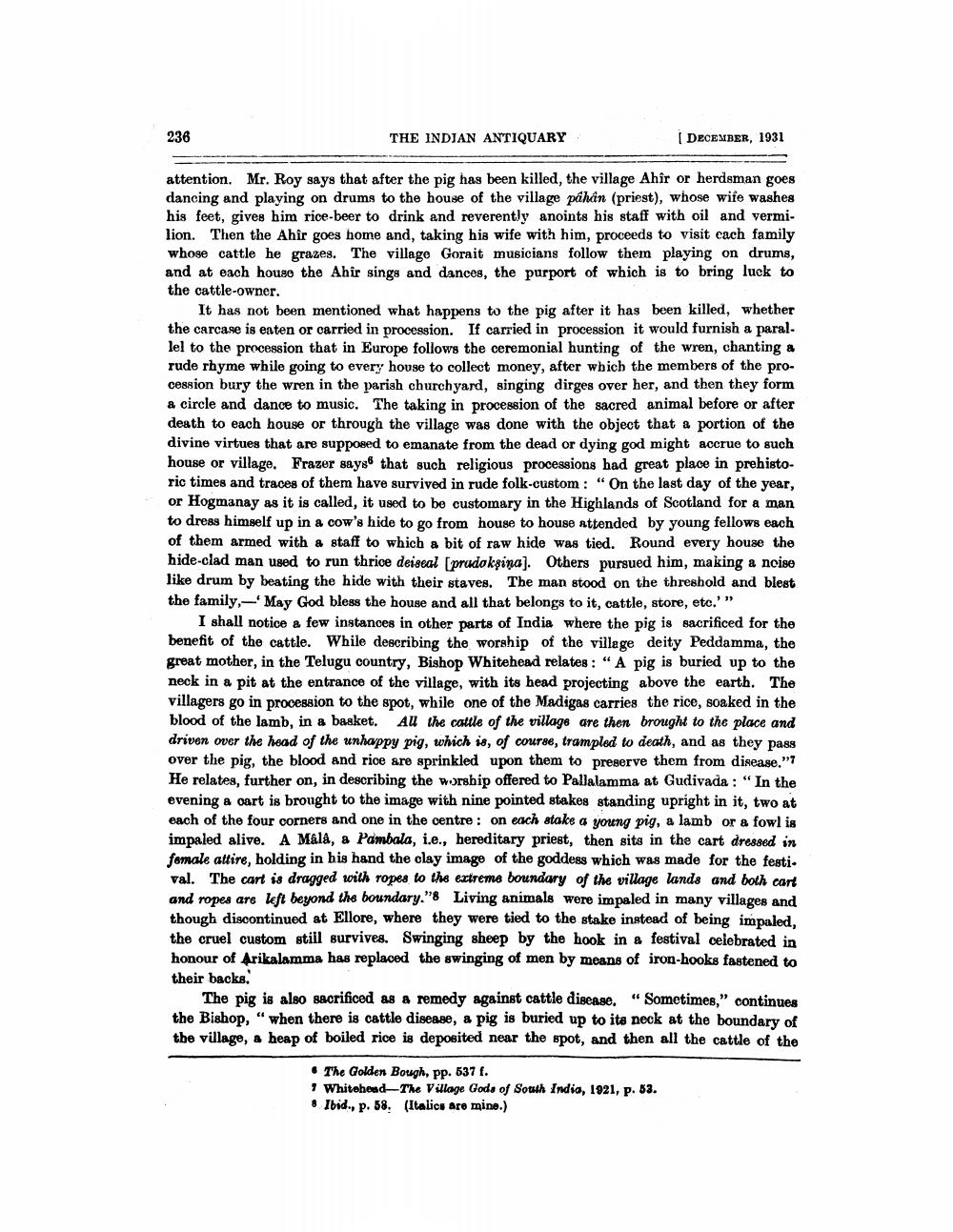________________
236
THE INDJAN ANTIQUARY
DECEMBER, 1931
attention. Mr. Roy says that after the pig has been killed, the village Ahîr or herdsman goes dancing and playing on drums to the house of the village pâhân (priest), whose wife washes his feet, gives him rice-beer to drink and reverently anoints his staff with oil and vermilion. Then the Ahir goes home and, taking his wife with him, proceeds to visit cach family whose cattle he grazes. The village Gorait musicians follow them playing on drums, and at each house the Ahir sings and dances, the purport of which is to bring luck to the cattle-owner.
It has not been mentioned what happens to the pig after it has been killed, whether the carcase is eaten or carried in procession. If carried in procession it would furnish a paral. lel to the procession that in Europe follows the ceremonial hunting of the wren, chanting & rude rhyme while going to every house to collect money, after which the members of the procession bury the wren in the parish churchyard, singing dirges over her, and then they form a circle and dance to music. The taking in procession of the sacred animal before or after death to each house or through the village was done with the object that a portion of the divine virtues that are supposed to emanate from the dead or dying god might accrue to such house or village. Frazer says that such religious processions had great place in prehistoric times and traces of them have survived in rude folk-custom : "On the last day of the year, or Hogmanay as it is called, it used to be customary in the Highlands of Scotland for a man to dress himself up in a cow's hide to go from house to house attended by young fellows each of them armed with a staff to which a bit of raw hide was tied. Round every house the hide-clad man used to run thrice deiseal prudokşina). Others pursued him, making a noise like drum by beating the hide with their staves. The man stood on the threshold and blest the family, May God bless the house and all that belongs to it, cattle, store, etc.'"
I shall notice a few instances in other parts of India where the pig is sacrificed for the benefit of the cattle. While describing the worship of the village deity Peddamma, the great mother, in the Telugu country, Bishop Whitehead relates : "A pig is buried up to the neck in a pit at the entrance of the village, with its head projecting above the earth. The villagers go in procession to the spot, while one of the Madigas carries the rice, soaked in the blood of the lamb, in a basket. AU the cattle of the village are then brought to the place and driven over the head of the unhappy pig, which is, of course, trampled to death, and as they pass over the pig, the blood and rice are sprinkled upon them to preserve them from disease."7 He relates, further on, in describing the worship offered to Pallalamma at Gudivada: "In the evening a cart is brought to the image with nine pointed stakes standing upright in it, two at each of the four corners and one in the centre : on each stake a young pig, a lamb or a fowl is impaled alive. A Mála, a Pambala, i.e., hereditary priest, then sits in the cart dressed in female attire, holding in his hand the clay image of the goddess which was made for the festi. val. The cart is dragged with ropes to the extreme boundary of the village lands and both cart and ropes are left beyond the boundary.”& Living animals were impaled in many villages and though discontinued at Ellore, where they were tied to the stake instead of being impaled. the cruel custom still survives. Swinging sheep by the hook in & festival celebrated in honour of Arikalamma has replaced the swinging of men by means of iron-hooks fastened to their backs.
The pig is also sacrificed as a remedy against cattle disease. "Sometimes," continues the Bishop," when there is cattle disease, a pig is buried up to its neck at the boundary of the village, a heap of boiled rice is deposited near the spot, and then all the cattle of the
• The Golden Bough, pp. 537 f.
Whitehead-The Village Gods of South India, 1921, p. 53. . Ibid., p. 58. (Italics are mine.)




